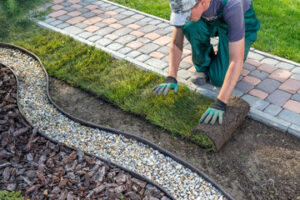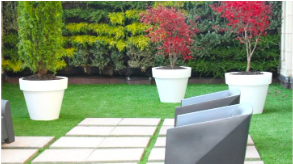Landscaping 101
Landscaping encompasses all visible features of a property’s outdoor space. These include plants, retaining walls, pathways, pavement, garden sculptures, and fences.
Form ties the landscape together and helps establish a theme. Whether perceived or actual, a line can make your landscaping more cohesive and visually appealing. Visit https://www.primecutlawnky.com/ to learn more.
Among the most important aspects of landscaping is the selection and placement of plants. The “right plant, right place” principle is one of the most fundamental art- and science-based concepts in landscape design. It requires consideration of the environmental conditions on a site and the desires and needs of the people who will use it.
Landscape architects consider the ecological implications of plant choices as well as the aesthetic possibilities. They select plants for their ability to perform a function such as soil erosion control or reducing air temperature. They also select plant materials that are tolerant of the environmental conditions on a site, such as salt spray and salinity.
The type of light a site receives also influences the selection of plant material. Shade from trees and buildings may provide too much or too little light for some species. The amount of reflected heat from buildings or structures affects the selection of plant materials as well.
Early land plants evolved special tissues and cells called vascular tissue to absorb and transport water, nutrients, and manufactured food around the body. This enabled them to grow larger and to develop a more complex body that supported the growing parts of the plant. The vascular tissues, xylem and phloem, link all parts of the plant to help it absorb and transport resources as needed.
Many landscape designers and gardeners are choosing to use native plants in their gardens. The practice is not only ecologically sound but often saves money. Using native plants in the landscape also provides habitat for birds, insects and other wildlife. The number of bird species that visit a site increases with the presence of native plants, and this can be a very positive aspect of landscape design.
Exotic ornamental plants currently dominate esthetically-managed landscapes, which cover 30-40 million hectares in the US alone. Recent ecological studies suggest that exotic plant species reduce biodiversity on multiple trophic levels. Increasing the percentage of native plants in landscaping will require a combination of efforts, including improving the genetics and breeding of existing plants and developing new cultivars with desirable ornamental traits.
Lighting
Lighting is a key component of any landscape design. Lighting is used for practical purposes such as illuminating walkways and steps to avoid tripping hazards, but also to create a more attractive aesthetic by highlighting your trees, plants, and other features of your property at night. When done properly, lighting can dramatically enhance the overall look of your landscape and even add to your home’s value.
Landscape lights can provide multiple benefits to homeowners and businesses alike. It can increase the safety of walkways, highlight tripping hazards, and illuminate important aspects of your property, such as a water feature or an accent tree. In addition, it can also create a warm and inviting feeling to your home after dark.
There are many different types of landscape lighting, each with their own unique effect. For example, up-lighting is an effective way to highlight certain trees or landscape structures by directing light upwards and creating dramatic shadows on their surfaces. Alternatively, down-lighting is used to draw attention to certain elements of your landscape by aiming the light downwards.
In general, it’s a good idea to separate your landscape into regions or zones when planning out your lighting. This will help you keep the project manageable, and make it easier to achieve your goals.
For example, if your goal is to illuminate pathways and walkways for safety reasons, you can start by lighting up the pathways near your house. From there, you can move outward and light up more areas. It’s also a good idea to test your lights at night, so that you can ensure the brightness, tone, and color temperature are appropriate for your space.
There are numerous benefits to having a well-planned landscaping, but it’s crucial that you choose the right contractor to get the job done. A professional landscaping company can help you with every step of the process, from conception to installation and maintenance. They can also advise you on the best options to fit your needs and budget. So, don’t hesitate to contact a landscaper for your next landscaping project!
Water
Water provides coolness, moisture, sparkle, lightness, depth, serenity, the possibility of aquatic plants and animals, and recreation. In nature it runs downhill through natural streams and rivers to form lakes, ponds, seas and oceans. It may be kept in structural channels and pools, recirculated to avoid waste, and pumped uphill into jets and fountains.
Water is essential to all landscapes. In Central Oregon, where the landscape is arid, water features are incredibly popular because they spritz up a dry desert garden. They also attract birds, butterflies, dragonflies, frogs and fish to the garden. The sound of flowing water has been shown to reduce stress and promote relaxation. It has been suggested that just standing near water emitted negative ions which help to lower blood pressure.
Adding a water feature to your landscape will also increase the humidity of the air, especially during our dry summers. This helps to keep the temperature down in the house and reduces dust. Water features also help to purify the air as the droplets of water vapor in the air carry pollution particles away. In addition, outdoor water features have been shown to create an environment in which the plants are healthier and grow better because the presence of the water increases the available nutrients to the soil. This is because the water is able to penetrate to the root zone better and carries away the salts that are normally in the irrigation water. In fact, irrigation water with a low sodium level (S-1) is the best water for use on fine textured soils. This is a more natural approach than using the highly salted water found in most municipal systems.
Design
Landscape design is the process of creating a plan for modifying an area of land. It involves determining what plants to grow, where to locate them and how to arrange them. It also includes planning for hardscapes, which are the non-plant features of the landscape, such as paths, patios and retaining walls.
The guiding principle of good design is balance and proportion. This is achieved through repetition of line, form, color and texture. Repetition must be used sparingly, however, or it may create monotony. For example, the use of a geometric shape, such as a square, repeated in an organized pattern can add balance and harmony to a garden.
Plants, hardscape and waterscape features should be scaled to the building and to each other. For instance, a path designed for walking with another person should be larger than one intended for a single individual. In addition, the use of a grid system can help organize the landscape and ensure that all elements fit together properly.
A garden should have focal points, which are areas that draw the eye and create a sense of direction. These are created with the use of lines, whether they are perceived (a series of plants or other features lined up in a row that lead to a location) or physical (a walkway or path that leads to the feature).
The use of color is an important aspect of a landscape’s design. Warm colors, such as red and yellow, excite the senses, while cool colors such as blues and greens calm the mind. Color can also be used to create contrast and to emphasize a particular element or area of the landscape.
Landscaping can have a number of benefits, from increasing the value of a home to improving the quality of life. It can also help protect the environment by reducing the amount of pollution from cars and other sources. By planting native flora and avoiding the use of chemicals, landscaping can contribute to the overall health of an ecosystem.
To find out what type of landscaping best suits your property, take the time to observe other homes and gardens in your neighborhood. Note the plant material and hardscape features that you like. Study these features to learn how they work together and what makes them attractive.

